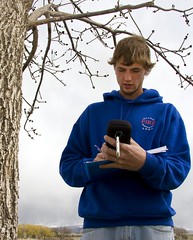May 19, 2010
University of Montana Western Department of Environmental Science Associate Professor Linda Lyons systematic botany students spent the last block of the spring semester taking an inventory of trees on public land in Dillon, identifying species, measuring tree size, assessing tree health, marking GPS locations and entering all the information in a database created by Donald Copple of the Department of Natural Resources and Conservation.
Environmental interpretation major Josh Hanson, environmental science major Brandon Job, and biology major Colter Dickinson were Lyons three students for Block 8. The small class allowed them to get a significant amount of work done in just 18 days.
The class was designed to use the project as a major service learning component, Lyon said. The fact that the students surveyed all of the public trees in Dillon in a little over two weeks showed a lot of enthusiasm and commitment on their part to complete the project.
 Josh Hanson said the project gave them invaluable real-world experience. Facilitated by Montana Westerns block scheduling program, Experience One, Hanson said the class allowed them to immediately apply class information to work in the field.
Josh Hanson said the project gave them invaluable real-world experience. Facilitated by Montana Westerns block scheduling program, Experience One, Hanson said the class allowed them to immediately apply class information to work in the field.
It relates to how your job will be when you graduate, Hanson explained. Block scheduling really helped with that. You can come to class, talk about it, and then go do it.
As part of the class, the students learned how to identify and classify plants as well as trees.
The students found 18 different species of trees. Their findings showed the overall health of Dillons trees is good, but the diversity is poor. Of the living trees they surveyed, 63 percent were green ash, which raised concern about the spread of the emerald ash borer among Dillons green ash. Such a low diversity would make Dillon much more susceptible to an infestation by the insect, which is currently in Minnesota and Wisconsin.
On May 4, the three students presented their findings and recommendations to the Dillon City Council and the Dillon Tree Board. The students recommended the city keep a close watch on the green ash to monitor for infestation. They also recommended a beautification project for Dillon, which could include the planting of native shrubs and grasses in public parks, schools and boulevards. Chokecherry, serviceberry, dogwood, currant and gooseberry were a few of the shrubs the students recommended planting.
 The students also recommended that Dillon participate in Tree City U.S.A., a national tree planting project. Participation requires a city tree ordinance. Grants to purchase plants and trees are available through the program.
The students also recommended that Dillon participate in Tree City U.S.A., a national tree planting project. Participation requires a city tree ordinance. Grants to purchase plants and trees are available through the program.
Chris Flintoff, the Secretary of the Dillon Tree Board, said the students service learning was a real boon to Dillon and provided invaluable help to the Tree Boards inventory and planting efforts.
With their help, we were able to focus and go forward, Flintoff said. Without them we would not have made our deadline to get the tree survey done.
Ann Egan, who also serves on the Dillon Tree Board, said the students efforts not only help provide valuable information for Dillon but could also provide added motivation to add more plant and tree life to the city.
Its nice to see their enthusiasm and interest, Egan said. They learned a lot and took the project seriously, It helps bring an awareness and could help make Dillon more open to beautification efforts.
Aside from the knowledge and experience they gained from the project, professor Linda Lyon said the students also gained a sense of pride.
It makes them proud to be able to apply the skills theyre learning, Lyon said.